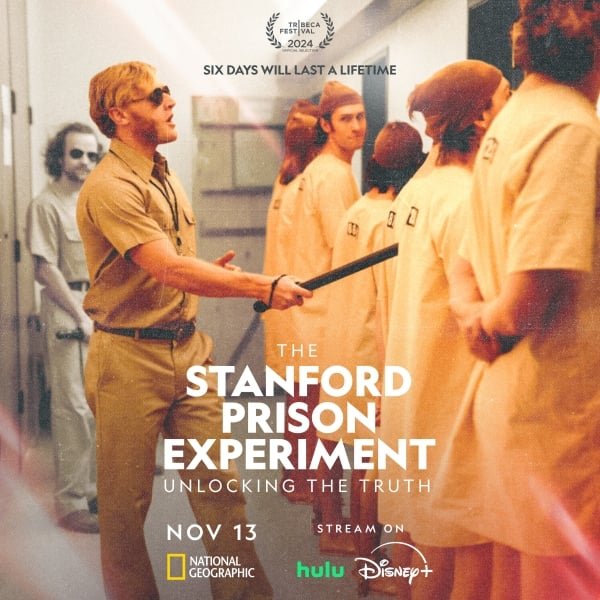Review of Stanford Prison Experiment documentary (opinion)
The Stanford Prison Experiment: Unlocking the Truth—a limited series that just premiered on the National Geographic channel and is streaming on Disney+ and Hulu—represents at least the sixth time the events of 1971 have been portrayed at length onscreen, whether in documentary format or as quasi-fictional drama. How could anyone squeeze almost three hours’ worth of video narrative out of such thoroughly covered events? I sat down to watch the preview screener prepared to hit fast-forward, as necessary.
In fact, it never was. The series is artfully constructed and eminently bingeable. Its narrative arc passes through more layers of context than even someone aware of the relevant history is likely to see coming.
Many readers of this column (perhaps most) already know something about the experiment itself, with its well-nigh legendary use of undergraduates as guinea pigs in the days before institutional review boards kept an eye on such things.
But anyone drawing a blank can see from this 10-minute video why the experiment has long been a staple of introductory psychology textbooks. It was provocative—and still is, though for different reasons now.
The professor who conducted the experiment, Philip Zimbardo (1933–2024), always presented its design and findings as fairly clear cut. The guards and prisoners were selected at random from the same, apparently homogeneous pool of participants (i.e., young, white, male Stanford students without criminal histories and judged to be in good mental health).
When their interactions quickly devolved into sadism and rebellion, the decisive factor was not racial tension—or some psychological trait shared by either group—but, rather, the simulated prison environment itself.
The events at Stanford played out just weeks before the Attica prison riot. Newspaper and television reporters who had paid scant attention to Zimbardo’s initial press releases suddenly found their interest piqued. The availability of six hours of film footage shot during the experiment was a windfall for media exposure. And the experiment’s impact is difficult to separate from its telegenic aspects.
On the National Geographic program, a parade of video clips across the decades show that Zimbardo was the ideal talk-show guest: earnest but personable and willing to elide inconvenient details in the interest of a striking narrative.
Early accounts reported that the guards’ attitudes toward the inmates ranged from friendliness to aggressive contempt.
But in the course of repeated media appearances, Zimbardo came to treat the prison conditions’ impact as uniform and inescapable: All the guards became domineering, at least in the publicity-friendly version.
And indeed, the most hostile and bullying guards do set the tone of the footage shot during the experiment—especially the guard nicknamed John Wayne by his peers, who assumes the alpha position with gusto. But in a recent interview, one of the less enthusiastic guards describes being taken aside by Zimbardo and encouraged to participate with more vigor.
Likewise, the alpha guard recalls Zimbardo encouraging him to assume leadership. He had a background in theater and saw himself as playing a character—one inspired by the prison movie Cool Hand Luke.
The participants interviewed for the documentary agree that Zimbardo held certain expectations about what would happen. He was critical of prison as an institution, as were some of the experimental subjects.
Zimbardo may not have expected things to escalate so rapidly, but the overall trajectory was much as expected. A press release issued shortly after the experiment started already referred to “reforms needed at a psychological level in order that men who commit crimes are not made into dehumanized objects by their prison experience …” That the guards themselves felt dehumanized by the proceedings comes through in interviews.
In 2019, the French scholar Thibault Le Texier published a paper in the American Psychological Association’s flagship journal under the title “Debunking the Stanford Experiment,” drawing on archival sources and interviews with 15 of the experiment’s 24 subjects. It summarized the findings of a monograph he had published the year before, now out in translation as Investigating the Stanford Prison Experiment: History of a Lie (Springer). Le Texier briefly appears in the documentary, but his influence is evident beyond that: The makers have followed in the wake of his research, but without endorsing the characterization of Zimbardo’s conduct as dishonest.
That is left to the surviving participants to do. Most of them felt, or came to feel, misled or abused by the experiment, or exploited by Zimbardo to further his media stardom from the 1970s on. If I read my notes correctly, he is referred to twice as “the disco psychologist,” which was among the less hostile remarks.
Zimbardo appears in the third episode, responding to criticisms and letting his own vituperations fly, but he is ultimately confident that the experiment demonstrated something about how evil situations can turn good people into monsters. I don’t know if the story will ever reach the screen again, but it’s unlikely to improve on this rendition.
You may be interested

Colorado lands 5-star quarterback amid Deion Sanders NFL coaching rumors
new admin - Nov 21, 2024[ad_1] The Colorado Buffaloes don’t play their next game until Saturday when they take on Kansas, but the football program…

Nov 21: CBS News 24/7, 1pm ET
new admin - Nov 21, 2024Nov 21: CBS News 24/7, 1pm ET - CBS News Watch CBS News Former Florida Rep. Matt Gaetz announced he…

WhatsApp will soon transcribe your voice messages
new admin - Nov 21, 2024WhatsApp is introducing a new transcription feature that makes it easier (and more convenient) to communicate using voice messaging. The…




































